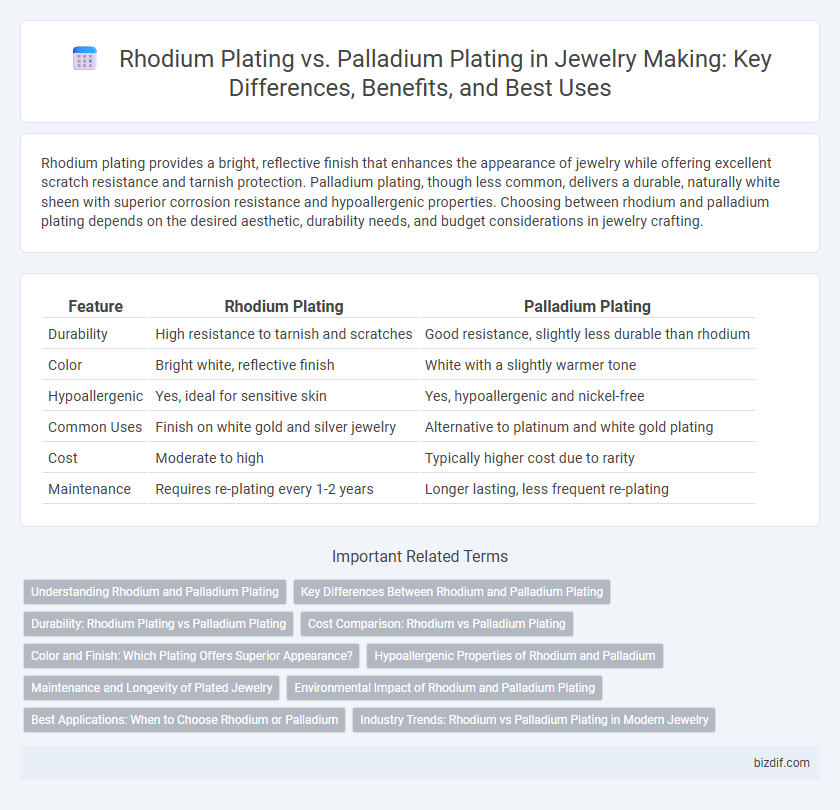Rhodium plating provides a bright, reflective finish that enhances the appearance of jewelry while offering excellent scratch resistance and tarnish protection. Palladium plating, though less common, delivers a durable, naturally white sheen with superior corrosion resistance and hypoallergenic properties. Choosing between rhodium and palladium plating depends on the desired aesthetic, durability needs, and budget considerations in jewelry crafting.
Table of Comparison
| Feature | Rhodium Plating | Palladium Plating |
|---|---|---|
| Durability | High resistance to tarnish and scratches | Good resistance, slightly less durable than rhodium |
| Color | Bright white, reflective finish | White with a slightly warmer tone |
| Hypoallergenic | Yes, ideal for sensitive skin | Yes, hypoallergenic and nickel-free |
| Common Uses | Finish on white gold and silver jewelry | Alternative to platinum and white gold plating |
| Cost | Moderate to high | Typically higher cost due to rarity |
| Maintenance | Requires re-plating every 1-2 years | Longer lasting, less frequent re-plating |
Understanding Rhodium and Palladium Plating
Rhodium plating provides a brilliant white finish that enhances jewelry durability by increasing scratch resistance and preventing tarnish, making it ideal for white gold and silver pieces. Palladium plating offers a similar lustrous appearance with added benefits of being hypoallergenic and more resistant to corrosion, commonly used in platinum jewelry. Both coatings serve to protect metals while enhancing aesthetic appeal, but their composition and durability nuances influence the choice based on specific jewelry requirements.
Key Differences Between Rhodium and Palladium Plating
Rhodium plating provides a bright, reflective white finish and is highly resistant to tarnish and scratches, making it ideal for enhancing the brilliance of white gold and silver jewelry. Palladium plating offers a slightly warmer tone with excellent corrosion resistance and hypoallergenic properties, often used as a durable, lightweight alternative to platinum. The primary differences lie in their color tone, durability, cost, and chemical resistance, with rhodium being harder and more reflective while palladium offers better malleability and subtle warmth.
Durability: Rhodium Plating vs Palladium Plating
Rhodium plating offers exceptional durability by creating a hard, scratch-resistant surface that maintains its shine longer on jewelry pieces. Palladium plating, while also durable, provides a softer finish that may show wear faster but offers superior resistance to tarnish and corrosion. Comparing both, rhodium plating is ideal for high-traffic jewelry such as rings, while palladium plating suits items requiring sustained anti-tarnish properties.
Cost Comparison: Rhodium vs Palladium Plating
Rhodium plating generally costs more due to rhodium's rarity and higher market price compared to palladium. Palladium plating offers a more budget-friendly alternative while still providing excellent durability and corrosion resistance. Cost differences influence choice depending on jewelry piece value and desired finish longevity.
Color and Finish: Which Plating Offers Superior Appearance?
Rhodium plating delivers a bright, reflective white finish that enhances the brilliance of jewelry, making it a popular choice for white gold and silver pieces. Palladium plating offers a slightly warmer, natural white tone that is more subtle and less prone to yellowing over time. For superior appearance, rhodium plating is preferred for its high shine and reflective quality, while palladium plating provides a durable, elegant matte finish with long-lasting color stability.
Hypoallergenic Properties of Rhodium and Palladium
Rhodium plating is highly valued in jewelry making for its superior hypoallergenic properties, making it ideal for individuals with sensitive skin or metal allergies. Palladium plating also offers hypoallergenic benefits but is less common due to its slightly higher reactivity and cost. Both metals provide durable, tarnish-resistant finishes, but rhodium's exceptional resistance to causing allergic reactions positions it as the preferred choice for hypoallergenic jewelry coatings.
Maintenance and Longevity of Plated Jewelry
Rhodium plating provides a highly durable and tarnish-resistant finish, making jewelry maintenance easier and less frequent compared to other metals. Palladium plating offers excellent corrosion resistance but may require more regular upkeep to maintain its original luster due to slightly softer surface properties. Both plating types extend the longevity of jewelry, with rhodium generally favored for brighter shine retention and palladium preferred for hypoallergenic benefits.
Environmental Impact of Rhodium and Palladium Plating
Rhodium plating involves the use of toxic chemicals and generates hazardous waste that requires careful disposal to minimize environmental harm. Palladium plating has a lower environmental footprint, as it uses less harmful chemicals and produces fewer toxic byproducts during the plating process. Sustainable jewelry practices prioritize palladium plating due to its reduced ecological impact and compliance with green manufacturing standards.
Best Applications: When to Choose Rhodium or Palladium
Rhodium plating is best suited for white gold and silver jewelry, enhancing brightness and providing exceptional scratch resistance and tarnish protection. Palladium plating works well for platinum alternatives and pieces requiring a naturally white finish with enhanced durability against corrosion and wear. Choosing between rhodium and palladium depends on the base metal, desired finish longevity, and specific use cases like daily wear or fine jewelry preservation.
Industry Trends: Rhodium vs Palladium Plating in Modern Jewelry
Rhodium plating dominates the jewelry industry for its exceptional brightness and durable tarnish resistance, making it the preferred choice for high-end white gold and silver pieces. Palladium plating gains traction as a hypoallergenic and eco-friendly alternative, favored in sustainable and luxury markets for its natural white hue and resistance to wear. Industry trends show a growing consumer demand for palladium due to its ethical sourcing and lower environmental impact, while rhodium remains preferred for its superior hardness and reflective finish.
Rhodium plating vs palladium plating Infographic

 bizdif.com
bizdif.com